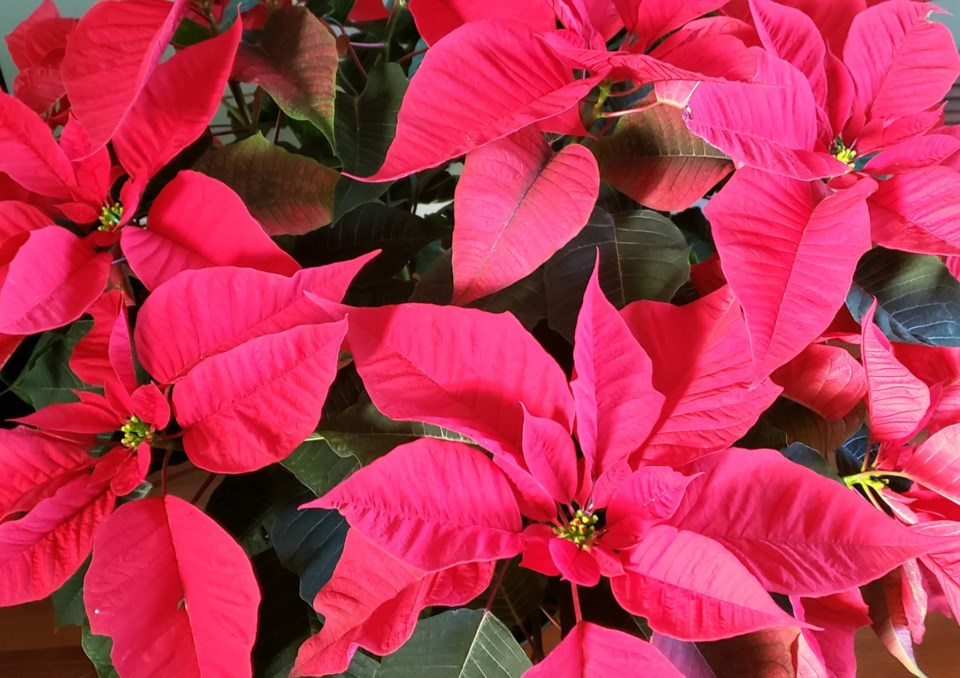The garden centres and other retail outlets are ablaze with holiday plants as the holiday season approaches. The most traditional holiday plant is of course the poinsettia. It is simply amazing to see these plants we associate with Christmas merrily blooming in climates known for their sand and sun. In their natural form, they are a large, leggy shrub that is adorned with lovely red “blooms” on the ends of the branches.
The Christmas poinsettia is a member of the large group of plants known as Euphorbias. The group displays extreme variability in growth habit, from succulent types so cactus-like in appearance that one member of the group was given the botanical name Euphorbia pseudocactus to leafy spurge (Euphorbia esula) which is considered a noxious weed. However, the Christmas poinsettia (Euphorbia pulcherrima) is the most famous member of this diverse group of relatives. The species name pulcherrima means “most beautiful” and market sales support that we as consumers agree. Poinsettias say Christmas everywhere and 70% of the poinsettias grown are sold in regions that never get snow.
Poinsettias are native to southern Mexico and Central America. Although red is still the best-selling poinsettia, plant breeders have produced many different cultivars with various shapes and colours. Joel R. Poinsett is the man given credit for introducing this plant into the United States when he was the first ambassador to Mexico from 1825 to 1829. As he was a scientist and a botanist, he noticed these shrubs growing wild in the hills around Taxco and sent a few of these plants home to ΒιΆΉΚΣΖ΅ Carolina for his collection. He began propagating them in his greenhouse and giving them to friends and botanical gardens. It was only a few years later that poinsettias were being sold at Christmas time in and around New York and Philadelphia. It is the Ecke family whose name is most often associated with growing poinsettias as they did much selection and breeding work to produce smaller plants that were longer-lasting and vigorous in growth. The ‘Oak Leaf’ cultivar was the first of the poinsettias to retain some of its leaves while in bloom as earlier cultivars would have colourful bracts on leggy, leafless stems. Since the 1960s most of our poinsettias are hybrids and the result of even more improved selections.
The common feature linking all these plants together is their very distinct flowers. The red “flowers” of a poinsettia plant are not flowers at all, but merely bright red leaves arranged in star-like clusters at the ends of the branches. The bright bracts are designed to draw pollinating insects toward the inconspicuous but true flowers of yellowish hue in their centre. The word “bract” is a botanical term for any leaf that has lost its normal photosynthetic role to take on a more specialised role. If you observe any poinsettia “flower” carefully, you’ll find at least a couple of leaves that are partially green and partially coloured. These were caught mid-way when the plant switched into “flowering mode” and began changing new developing leaves into coloured bracts. In a short-day plant, poinsettias initiate flowering after exposure to an eight-week period where nights are at least 14 hours long. Commercial growers bringing them into flower for Christmas are therefore careful to ensure the plants experience nights of at least this length.
This Ode to the Poinsettia will continue for two more pieces that are devoted to this amazing plant. We hope that you are enjoying a poinsettia in your home and that perhaps you will gift a plant to some of the special people in your life.
Hanbidge is the Lead Horticulturist with Orchid Horticulture. Please find us at ; by email at [email protected]; on Facebook @orchidhort and on Instagram at #orchidhort. Tune into GROW Live on our Facebook page or check out the Youtube channel GROW
Bookmark SASKTODAY.ca, Saskatchewan's home page, at this link.




